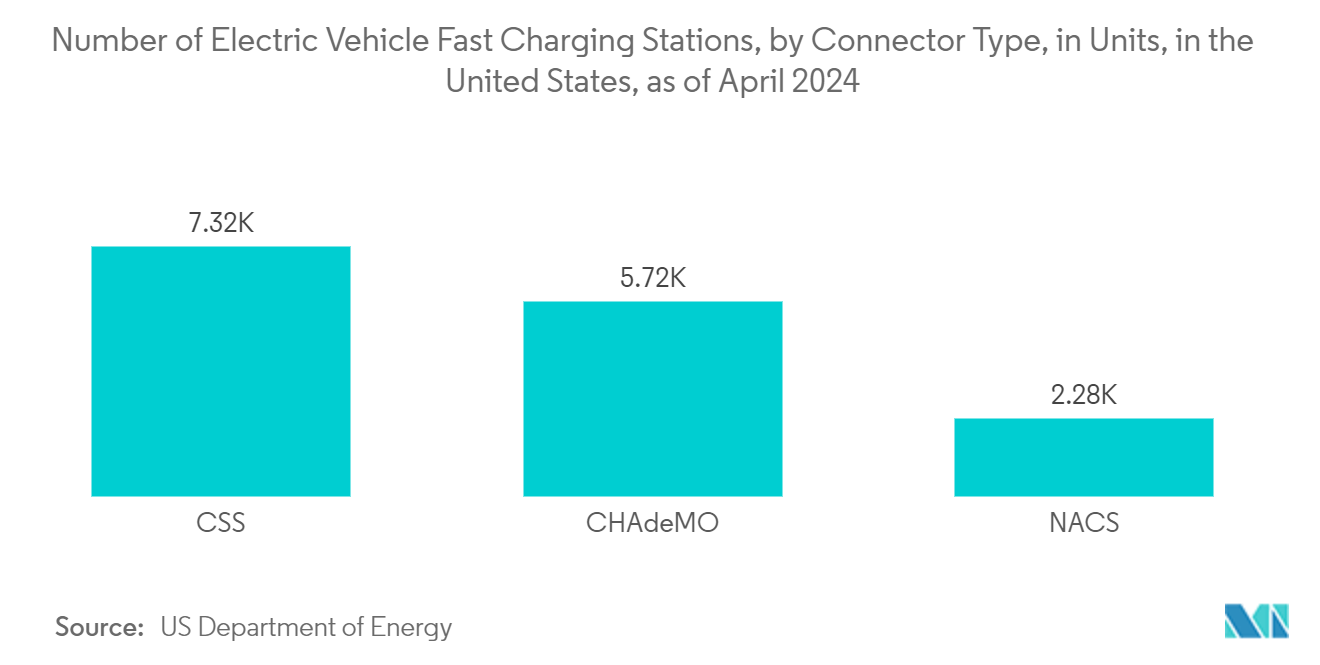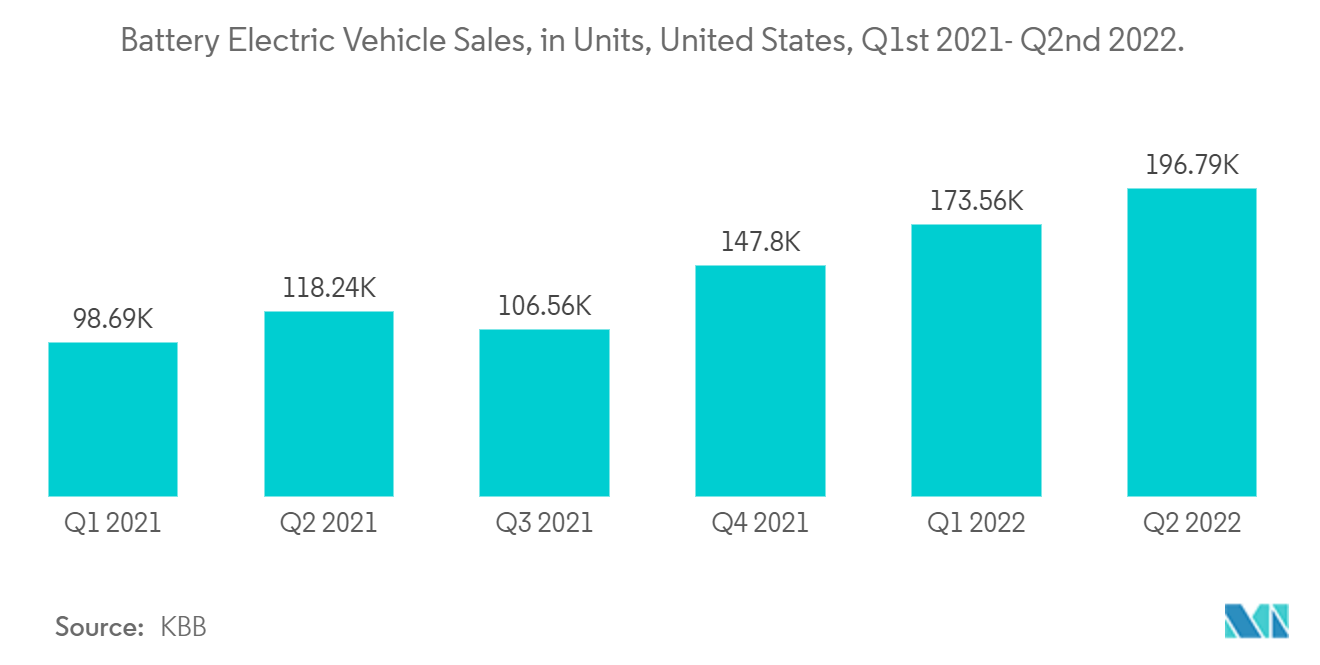Market Trends of Americas Semiconductor Device Industry
Discrete Semiconductor Hold Significant Market Share
- Discrete semiconductor in the united states is driven by the growing need to manage power across electronics and miniaturization. STMicroelectronics recently introduced its third generation STPOWER silicon-carbide MOSFETs, advancing the power devices for electric-vehicle (EV) powertrains and other applications where energy efficiency, power density, and reliability are essential to target criteria.
- Moreover, characteristics like safety, infotainment, navigation, fuel efficiency in the automotive components, and security, automation, solid-state lighting, transportation, and energy management in industrial parts are expected to fuel the market studied. For instance, in July 2022, STMicroelectronics launched 40V MOSFETs, STL320N4LF8 and STL325N4LF8AG, featuring energy efficiency and low noise in circuits for power conversion, motor control and power distribution.
- The increasing capability of renewable energy generation is expected to indirectly lead to increased application of discrete semiconductors devices to maintain power efficiency. According to IEA, in 2022, electricity generation from wind amounted to nearly 435 terawatt hours. By comparison, electricity generation from solar photovoltaics raised at 146 terawatt hours.
- A significant trend in discrete semiconductors is efficient energy management. New system architectures are improving AC-DC power adapters' efficiency while reducing the size and component count. New standards for Power-over-Ethernet (PoE) allow higher power transfer, enabling the development of new devices, like connected lighting.
- Furthermore, the zero-emission shift trend is enabling automotive manufacturers to invest in EVs and Hybrid EVs. The factor mentioned above accounts for a significant opportunity for discrete power semiconductors, as vehicle electrification drives automotive demand.
- For instance, Alpha and Omega Semiconductor Limited, a designer, innovator, and supplier of power semiconductors, power ICs, and digital power products, recently released AEC-Q101 qualified 1200V silicon carbide (SiC) αSiC MOSFETs in an optimized TO-247-4L package. It is intended for the high efficiency and reliability requirements of electric vehicles (EV) onboard chargers, motor drive inverters, and off-board charging stations. The 1200V SiC MOSFETs provide low on-resistance for an automotive-qualified TO-247-4L with a standard gate drive of 15V.
- Moreover, a smartphone is a significant consumer of discrete semiconductors. Smartphone transmission speeds are increasing dramatically, and the country is witnessing a transition from 4G to 5G. The expanded transmission speeds may lead to a boost in the volume of data being transmitted. This is anticipated to propel the need for more data centers. Hence, there would be a higher need for discrete components, saving energy and space.
- According to the GSM Association, by 2025, the United States is expected to have the most increased smartphone adoption globally (49% of connections). As per the IoT Association, the United States has the highest smart home device ratio per household and the most significant consumer propensity to own instruments across two or three use cases (energy, security, and appliances).

Automotive Sector to Experience Significant Market Growth
- Semiconductor chips have evolved into an integral part of modern-day cars, owing to their general use in various functions of vehicles. Chips used in cars can take many forms ranging from single components containing a single transistor to complex combined circuits controlling a complex system. For instance, chips are discovered in the LED light elements of vehicles. Every single diode inside an LED light unit is a chip that emits light. LED headlights alone account for a massive number of chips in modern-day cars. The headlights also require control units to make them function.
- The growing need for better security and advanced driver assistance systems (ADAS) in cars has accelerated the demand for semiconductors across the country. Intelligent functions, like backup cameras, blind-spot detection, adaptive cruise control, lane change assist, airbag deployment, and emergency braking systems, are made possible through semiconductor technologies. Further, ADAS covers a broad array of sensors, including image and camera sensors for vision-based features, ultrasonic sensors for short-range features like parking assist, and radar and lidar sensors for object detection under dark or foggy conditions.
- The increasing demand for electric vehicles is expected to open new growth opportunities for the studied market. An increased number of electronic devices and sensors are used in electric cars, driving the demand for semiconductor chips. For instance, according to KBB, in the Q2nd of 2022, just under 196,788 battery EVs were sold in the United States. This was a year-over-year increase of around 66.4% compared to the sales recorded in the Q2nd of the previous year. The Q2nd of 2022 also recorded a hike in sales compared to the Q1st of 2022, making it a significant quarter for Battery Electric Vehicles sales in the country across the past two years.
- Further, in March 2023, 93,318 HEVs (20,064 cars and 73,254 LTs) were sold in the United States, up 21.7% from the sales in March 2022. In addition, there were 208 Toyota Mirai, and 21 Hyundai Nexo sold in the United States in March 2023.
- In addition, Renesas Electronics Corporation, a supplier of advanced semiconductor solutions, announced the expansion of its collaboration with Honda in the field of ADAS in March 2022. Previously, Honda adopted Renesas' R-Car automotive system on a chip (SoC) and RH850 automotive MCU for its Honda SENSING Elite system featured in the Legend. With the expansion of the partnership, Honda will use R-Car and RH850 in the Honda SENSING 360 omnidirectional safety and driver assistance system.
- Moreover, the automotive industry has been hit by the current semiconductor shortage. Companies like Hyundai Motor are looking to develop their semiconductor chips to cut reliance on others. Furthermore, carmaker Ford recently signed a deal with chipmaker GlobalFoundries to help solve the auto industry's semiconductor supply shortfalls holding up production lines by collaboratively manufacturing automotive semiconductors in the United States.


